Photo
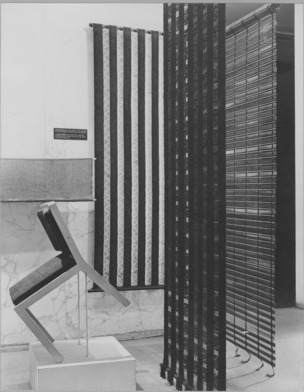
Anni Albers Textiles
#tbt to the landmark 1949 exhibition Anni Albers Textiles, the Museum’s first ever devoted to the work of a single textile artist. It surveyed Albers’s enormously creative output, from weaving experiments in corn, grass, and string, to drapery, upholstery, pictorial tapestry, and “room dividers” intended to create differentiated spaces within open architectural plans. Albers was a legendary arts educator who had studied and later become a weaving instructor at the Bauhaus school in Germany, where she met her husband, the artist and educator Josef Albers. After Nazi pressure forced the school to close in 1933, she and Josef moved to continue teaching at Black Mountain College in North Carolina, which is where she later prepared for her MoMA exhibition. Albers was closely involved with the exhibition, designing new textiles made expressly for the purpose. The exhibition was highly popular and subsequently traveled to 26 locations throughout North America.
See images of the installations and more at mo.ma/2nkTQuE. 29 of #52exhibitions
243 notes
·
View notes
Photo
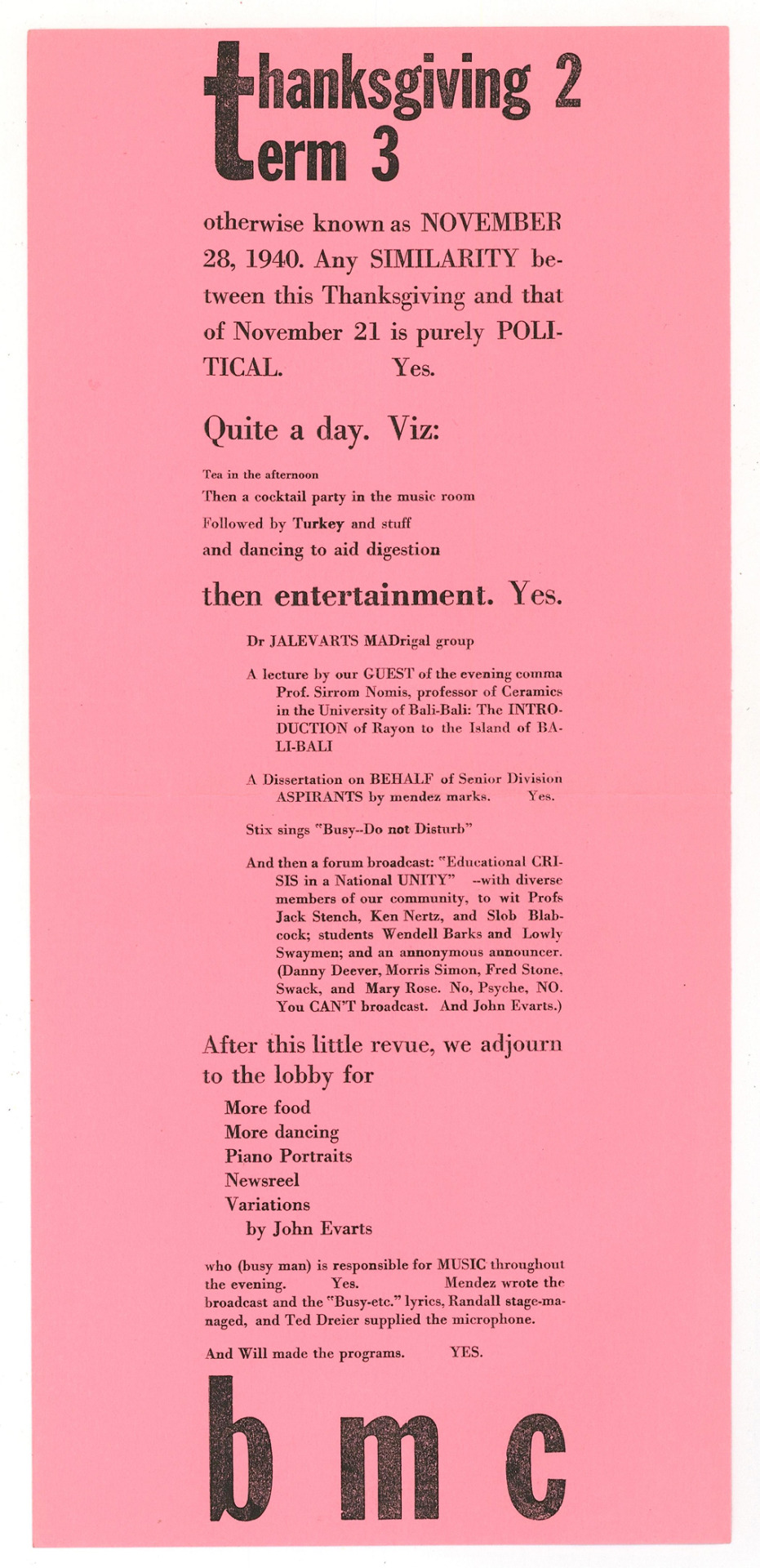
thanksgiving 2 term 3, November 28, 1940. Ink on Paper. BMCM+AC Permanent Collection.
11 notes
·
View notes
Video
vimeo
“Variations V,” 1965 - Intermedia work featuring the Merce Cunningham Dance Company with music by John Cage, projections and documentation by Stan Vanderbeek, TV distortions by Nam June Paik, theremins built by Robert Moog. Dancers: Merce Cunningham, Carolyn Brown, Barbara Lloyd, Sandra Neels, Albert Reid, Peter Saul, Gus Solomons Jr.
Intermedia, the cross pollination of differing genres and practices, is embodied in this collaborative piece from BMC alums Merce Cunningham, John Cage, and Stan Vanderbeek. Performance, dance, music, and video are in conversation and cut across the lines which divide them. Intermedia can be traced back to the first Happening in the BMC dining hall in 1952, conceived of in part by Cage and Cunningham.
#Vimeo#cage#cunningham#dance#moog#johncage#mercecunningham#stanvanderbeek#vanderbeek#moderndance#performanceart
3 notes
·
View notes
Photo
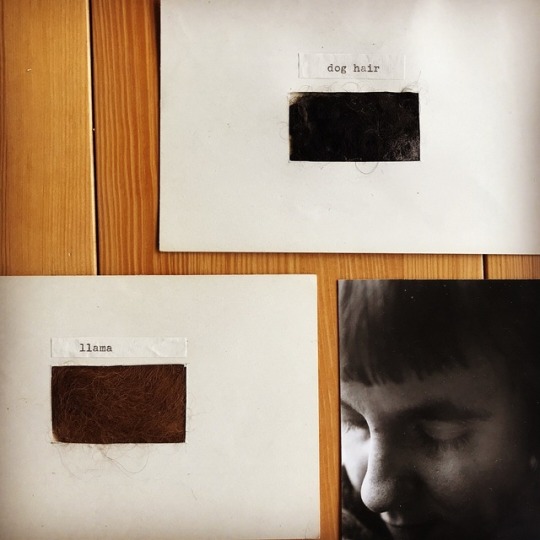
This week, we received an amazing surprise: these gifts from Janet Heling Roberts who was a BMC student in mid 1940s. Her donation includes original photos of Janet taken by Hazel Larsen Archer and sample weaving materials for one of Anni Albers’ assignments (dog hair, llama, camel...) Our permanent collection is shaped by gifts like this, with unique and intimate insights into daily life at BMC.
#bmc#blackmountaincollege#museum#history#photography#annialbers#hazellarsenarcher#janethelingroberts
8 notes
·
View notes
Video
youtube
In 1951, Charles Olson was hired as a visiting professor at Black Mountain College. He would eventually succeed Josef Albers as the college’s rector. His ideas influenced a whole generation of poets and writers, including Robert Creeley, Robert Duncan, Denise Levertov, Jonathan Williams, Hilda Morley, Joel Oppenheimer, and Paul Blackburn.
(via https://www.youtube.com/watch?v=E85iFHTKrAI)
4 notes
·
View notes
Photo
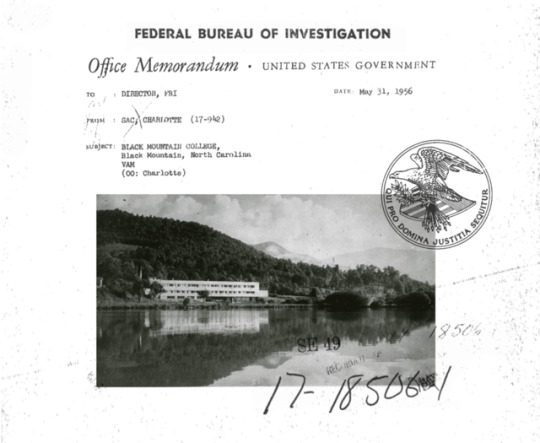
FBI Investigation of Black Mountain College, 1956
There are many different reasons that the BMC closed its doors, but one may stand out from the others: the FBI’s investigation in 1956. Unendowed, BMC was reliant upon tuition to stay afloat. This was all the more urgent in the late 1950s when attendance was already dropping. In 1956, nine out of the 23 students at BMC were veterans funded through the G.I. Bill. Hearing rumors about the unorthodox education received there, The Veterans Administration decided to take a closer look at BMC in April of 1956, approaching the FBI to investigate the legitimacy of the college.
From their investigation, FBI agents stated that BMC faculty are “conducting a very unusual type of school, for example, a student may do nothing all day and in the middle of the night may decide he[sic] wants to paint or write, which he does, and he may call upon his teachers at this time for guidance. They advised that everything is left to the individual.” The overall liberal atmosphere of the college garnered much public attention, and aroused suspicion that the college was fostering communist sympathies.
In the age of McCarthyism, Blacklisting and The Red Scare, Black Mountain College faced a formidable battle against perception and government red tape. Despite the FBI finding insufficient evidence to persecute the college, the damage from lack of VA funding had been done.
Ironically, the closure of the Bauhaus due to the political antagonism of the Nazi Party was led by fear of faculty’s liberal, communist leanings. Members of the Bauhaus such as the Albers and Walter Gropius came to BMC to revive its ideals. It would be similar censorship and paranoia, this time on behalf of the United States Government, that would contribute to BMC’s closing in 1957.
The FBI file can be read in it’s entirety here: http://bit.ly/2zAeT5T
More information on the investigation can be found through our Research Resources here: http://bit.ly/2z0ChKj
45 notes
·
View notes
Photo
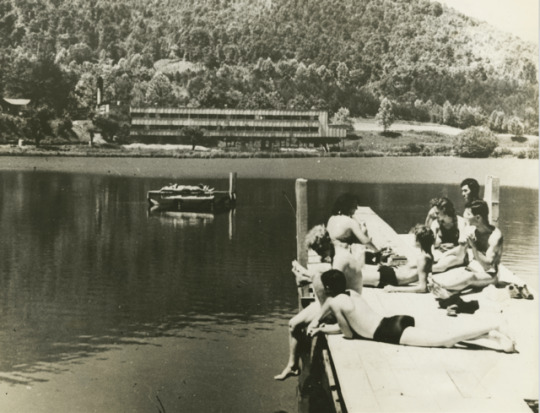
Student Life at Black Mountain College
Nestled in the hills of North Carolina, along the shores of Lake Eden, Black Mountain College seemed like utopia for many students. With little more than a few dozen students at a time and with very few matriculating through a “full degree” (this was never truly the goal), BMC featured an ever evolving cast of characters. All were living and working in close quarters and relying upon cooperation in the daily running of the school, farm, and campus. The most monumental example of this is featured in the background of this photo. The Studies Building, designed by A. Lawrence Kocher was built by the students in 1943. Each student was assigned a study within this building where they would work. The law of the land was that if any student’s study door was closed, no matter what, they were not to be disturbed. Between studio time, intensive courses, farmwork, and countless other tasks, these students found a moment to take in the sun on the dock near the Dining Hall.
Students lounging on dock, Lake Eden, n.d. Photo by Josef Breitenbach. Courtesy Western Regional Archives, State Archives of North Carolina, Asheville, NC.
11 notes
·
View notes
Photo
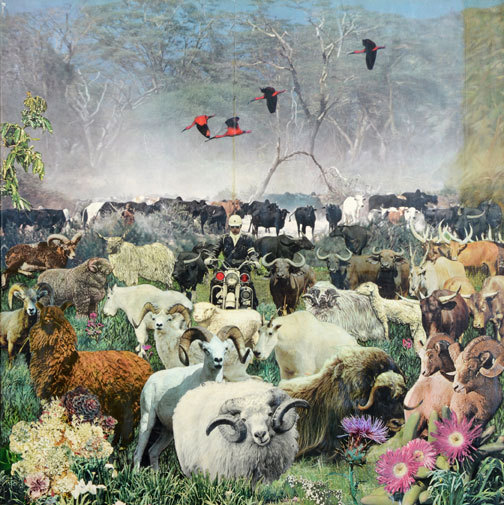
Suzi Gablik is an artist, art historian, critic, and educator. Gablik attended Black Mountain College in 1951 before studying under former BMC educator Robert Motherwell at Hunter College where she received her B.A. in 1955. Her focus shifted from visual arts to art criticism in the 1970s as she began to examine the responsibility of art for social change. In her 1984 book Has Modernism Failed? Gablik called out contemporary art for its lack of idealism, a quality that drove the early modern movement. This idealism was at the backbone of Black Mountain College with educators like Buckminster Fuller, Josef and Anni Albers, and Walter Gropius who saw modernism as a means to a more socially just future.
Suzi Gablik, Tropism #9, collage and oil on canvas, 1970. BMCM+AC Permanent Collection. Gift of the Artist.
#modernism#modernart#art#femaleartists#collage#1970s#bmc#blackmountaincollege#suzigablik#contemporaryart
7 notes
·
View notes
Photo
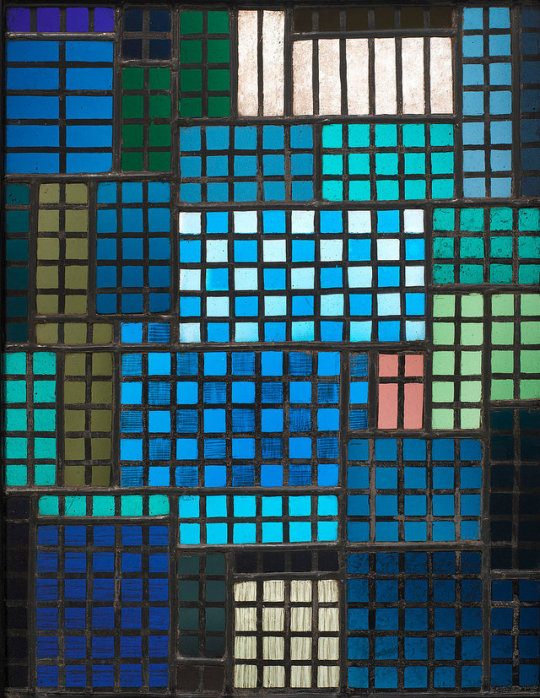
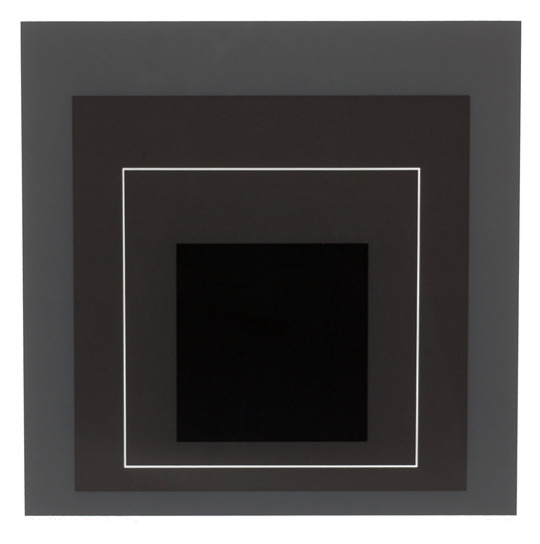

Josef Albers is possibly best known for his geometric patterns and prints, featured in Interaction of Color (1963). This was not, however, his favored medium when he first arrived at Black Mountain College in 1933, and if not for Asheville’s limited resources his practice may have taken a different direction. Ultimately, some of Albers’ greatest achievements in education were accomplished with ordinary construction paper.
Albers had been experimenting with the possibilities of glass as a student then Master at the Bauhaus. The son of a craftsman, Albers created stained glass works that showed the possibility of color to interact within geometric, minimal forms (top left).
Later, in an effort to further examine the line between wall painting and glasswork, he began making his sandblasted glass paintings (below). Sandblasting limited the light that could travel through the surface, as well as how light was reflected. This was his practice when the Bauhaus closed due to Nazi antagonism and Albers was invited to Black Mountain College to lead the department of art.
Upon arriving at Black Mountain in 1933, he found that not even the nearby city of Asheville had facilities equipped for him to continue his experimentations with sandblasting. At this point he turned his attention to painting, prints and collages, a process that he taught his students in his famed color theory course (a requisite for all students and evolution from his Bauhaus Preliminary Course). Students in this course would use colored construction paper to understand how color, line, and form interact in the creation of an artwork.
Albers developed the theory of Factual and Actual color. Factual color is color in isolation while Actual color is how a color is understood in association with the colors around it. The use of construction paper in his color theory courses allowed students to understand these subtle differences using a consistent and controlled material.
Top Left: Josef Albers, “Park,” ca. 1923, glass, metal, wire, and paint, 191⁄2 × 15 in (49.5 × 38.1 cm) © 2017 Josef and Anni Albers Foundation / Artists Rights Society (ARS), New York
Top Right: Josef Albers, Gray Instrumentation I, 1974, 5/36, silkscreen on paper, 19 x 19 inches (paper) 11 x 11 inches (image.) Gift of Philip Neal.
Bottom: Josef Albers, “Frontal,” ca. 1927, sandblasted flashed glass with black paint, 13 3⁄4 × 18 7⁄8 in (34.8 × 47.9 cm) © 2017 Josef and Anni Albers Foundation / Artists Rights Society (ARS), New York
3 notes
·
View notes
Photo


Robert Rauschenberg is shown here with his future wife and fellow artist Susan Weil at BMC in the summer of 1948, photographed by Hazel Larsen Archer. After this summer, they created their first collaborative “blueprint paintings.” These prints, created by using light to expose an object onto paper, exemplified the spirit of experimentation and collaboration at the heart of Black Mountain College. The couple have created a painting without brushstrokes, but which shows the "hand” of the artist in an undeniable way. They are reliant upon the unpredictable reaction of the blueprint paper to light. Both in the conceptualization and realization of this print, Weil and Rauschenberg are intertwined.
While their marriage ended in 1953, Weil and Rauschenberg continued to support and inspire each other until Rauschenberg’s death in 2008. Weil still creates and exhibits her art internationally and is one of the key influencers of the Abstract Expressionist movement.
Hazel Larsen Archer, “Robert Rauschenberg and Susan Weil,” c. 1948.
Robert Rauschenberg, Susan Weil. “Untitled [Double Rauschenberg],” c. 1950. Exposed blueprint paper. Cy Twombly Foundation.
#robertrauschenberg#rauschenberg#susanweil#bmc#blackmountaincollege#art#modernart#female artists#history#twentieth century
23 notes
·
View notes
Photo
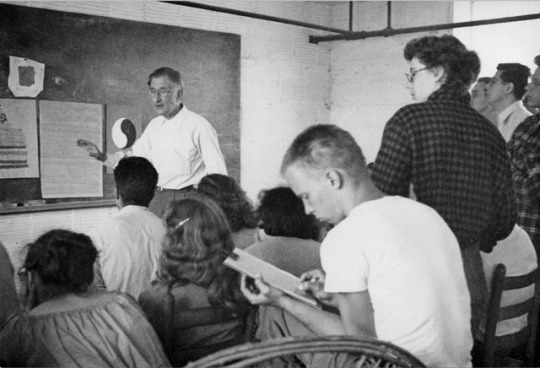
We’d like to introduce ourselves! We are a Museum + Arts Center in Asheville, NC that is dedicated to the history of Black Mountain College and its legacy. This Tumblr will be a spot to post updates on our exhibition and programs, never before seen photos from our permanent collection and archival photos like this one.
The story of Black Mountain College begins in 1933 and comprises a fascinating chapter in the history of education and the arts. Conceived by John A. Rice, a brilliant and mercurial scholar who left Rollins College in a storm of controversy, Black Mountain College was born out of a desire to create a new type of college based on John Dewey’s principles of progressive education. The events that precipitated the college’s founding occurred simultaneously with the rise of Adolf Hitler, the closing of the the Bauhaus school in Germany, and the beginning of the persecution of artists and intellectuals in Europe. Some of these refugees found their way to Black Mountain, either as students or faculty. Meanwhile, the United States was mired in the Great Depression.
The founders of the college believed that the study and practice of art were indispensable aspects of a student’s general liberal arts education, and they hired Josef Albers to be the first art teacher. Speaking not a word of English, he and his wife Anni left the turmoil in Hitler’s Germany and crossed the Atlantic Ocean by boat to teach art at this small, rebellious college in the mountains of North Carolina.
Black Mountain College was fundamentally different from other colleges and universities of the time. It was owned and operated by the faculty and was committed to democratic governance and to the idea that the arts are central to the experience of learning. All members of the college community participated in its operation, including farm work, construction projects, and kitchen duty. Twenty minutes east of Asheville, the secluded environment fostered a strong sense of individuality and creative intensity.
Legendary even in its own time, Black Mountain College attracted and created maverick spirits, some of whom went on to become well-known and extremely influential individuals in the latter half of the 20th century. A partial list includes Willem and Elaine de Kooning, Robert Rauschenberg, Josef and Anni Albers, Jacob Lawrence, Merce Cunningham, John Cage, Cy Twombly, Kenneth Noland, Susan Weil, Vera B. Williams, Ben Shahn, Ruth Asawa, Franz Kline, Arthur Penn, Buckminster Fuller, M.C. Richards, Francine du Plessix Gray, Charles Olson, Robert Creeley, Dorothea Rockburne and many others who have made an impact on the world in a significant way. Even now, decades after its closing in 1957, the powerful influence of Black Mountain College continues to reverberate.
(Hazel Larsen Archer, Josef Albers’s color theory class, n.d.)
#blackmountaincollege#bmc#bauhaus#germany#design#art#education#willemdekooning#elainedekooning#josefalbers#annialbers#jacoblawrence#mercecunningham#johncage#cytwombly#kennethnoland#susanweil#verabwilliams#benshahn#ruthasawa#franzkline#arthurpenn#buckminsterfuller#mcrichards#francineduplessixgray#charlesolsen#robertcreeley#dorothearockburn#johnandrewrice#johndewey
7 notes
·
View notes